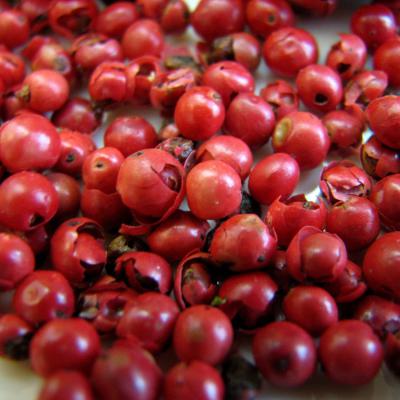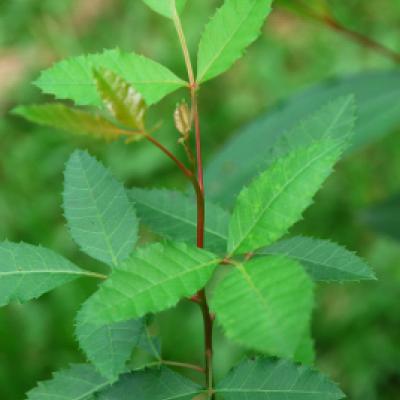Anacardiaceae-Schinus-terebinthifolius
Classification
- Botanical Family : Anacardiaceae
- Genus : Schinus
- Epithet : terebinthifolius
- German Family Name: Sumachgewächse
- English Name: Brazilian Pepper, Christmasberry
- Thai Name: (ไม่ทราบ)
- Thai Phonetic: (mai saab)
- Author: Raddi
Water Requirements
Plant Type
Light Requirements
Cultivation
Schinus terebinthifolius is not native to Thailand. Grows as a small tree up to 10 m high or as a shrub. It`s evergreen. The leaves smell like turpentine when it grinds.
It has no special demands at the soil.
Can be planted on spacious grounds only as a single plant, as in the vicinity of Schinus terebinthifolius other plants can not thrive. The tree is due to its dense foliage as shade. The little red fruit occurring in clusters are a nice contrast to the glossy green leaves of the tree.
Developed a large root. Grow invasively, i.e. overgrowns other plants. After cutting of the stem there grows new basal shoots very soon. This makes it difficult the growth of Schinus terebinthifolius to keep in control.
Can be trimmed as a bonsai.
Propagation: by cuttings or seeds
Schinus terebinthifolius ist nicht in Thailand heimisch. Wächst als kleiner Baum bis 10 m Höhe mit einer runden Krone oder als Strauch. Ist immergrün. Die Blätter riechen nach Terpentin, wenn man sie zerreibt.
Er stellt keine besonderen Ansprüche an die Bodenbeschaffenheit.
Kann nur als Solitärpflanze auf großzügigem Areal angepflanzt werden, da in der Umgebung von Schinus terebinthifolius andere Pflanzen nicht gut gedeihen. Der Baum gilt wegen seines dichten Laubes als Schattenspender. Seine in Trauben vorkommenden kleinen roten Früchte bilden einen schönen Kontrast zu den glänzend grünen Blättern des Baumes.
Entwickelt eine große Wurzel. Wächst invasiv, d.h. überwuchert auch andere Pflanzen. Nach dem Fällen des Stammes bilden sich basale Triebe. Das lässt die Wucherung des Schinus terebinthifolius nur schwer kontrollieren.
Kann auch als Bonsai gezogen werden.
Vermehrung: durch Stecklinge oder Aussaat
Origin
Miscelaneous
The fruits are often used as Christmas decorations, it is also called "Christmas berry".
Skin contact with leaves and the milky sap of Schinus terebinthifolius can cause red, itchy rashes, allergies and respiratory ailments. Even flu-like symptoms are reported.
Ethnomedical uses
The ethnomedical information is provided for general information only, it is not intended as guidance for medicinal use.
Used are the leaves and bark of the trunk.
Brazil - an antibacterial effect was detected. (1)
(1) Anti-bacterial activity of some Brazilian medicinal plants
- Maria Raquel Ferreira de Limaa, Josiane de Souza Lunaa, Aldenir Feitosa dos Santosa, Maria Cristina Caño de Andradea, Antônio Euzébio Goulart Sant’Anaa Jean-Pierre Genetb, Béatrice Marquezb, Luc Neuvilleb, Nicole Moreaub
- a Departamento de Química-CCEN, Universidade Federal de Alagoas, Cidade Universitária 57.072-970, Maceió, Alagoas, Brazil
- b Laboratoire de Synthèse Sélective Organique et Produits Naturels, UMR CNRS 7573, Ecole Nationale Supérieure de Chimie de Paris, 11 rue Pierre et Marie Curie, 75231 Paris Cedex 05, France
- Received 21 June 2004. Revised 14 September 2005. Accepted 13 October 2005. Available online 13 December 2005.
- Journal of Ethnopharmacology Volume 105, Issues 1–2, 21 April 2006, Pages 137–147
- http://www.sciencedirect.com/science/article/pii/S0378874105007452
Im 19. Jh. wurde Schinus terebinthifolius in Nordamerika als Zierpflanze eingeführt. Seit dem hat er sich sehr stark in den Sümpfen Floridas ausgebreitet und ist verwildert. Unter großem Aufwand wird versucht, den Baumbestand dort wieder zu reduzieren. Der Besitz und die Kultivierung von Schinus terebinthifolius steht in Florida unter Strafe.
Die Früchte dieser brasilianischen Gewürzpflanze werden unter der Bezeichnung „Rosa Pfeffer“, „Rosé Pfeffer“ oder „Rosa Beeren“ als Gewürz verwendet, sie sind jedoch kein echter Pfeffer, sondern werden buntem Pfeffer (schwarz, weiß und grün) aus optischen Gründen anstelle des verderblichen roten Pfeffers beigemischt. Sie sind von mild aromatischem Geschmack. Diese roten Früchte wirken jedoch toxisch beim Verzehr von größeren Mengen.
Die Früchte werden auch gerne als Weihnachtsschmuck und -dekoration verwendet, darauf beruht auch der Zweitname „Weihnachtsbeere“.
Der Hautkontakt mit Blättern oder dem Milchsaft von Schinus terebinthifolius kann zu rotem, juckendem Ausschlag, zu Allergien und Atemwegsbeschwerden führen. Selbst grippeähnliche Symptome werden berichtet.
Volksmedizinische Verwendung
Die Berichte über volksmedizinische Verwendung ist nur zur allgemeinen Information und nicht als medizinischer Ratgeber zu betrachten.
Verwendet werden die Blätter und die Rinde des Stammes.
Brasilien - eine antibakterielle Wirkung wurde nachgewiesen. (1)
(1) Anti-bacterial activity of some Brazilian medicinal plants
- Maria Raquel Ferreira de Limaa, Josiane de Souza Lunaa, Aldenir Feitosa dos Santosa, Maria Cristina Caño de Andradea, Antônio Euzébio Goulart Sant’Anaa Jean-Pierre Genetb, Béatrice Marquezb, Luc Neuvilleb, Nicole Moreaub
- a Departamento de Química-CCEN, Universidade Federal de Alagoas, Cidade Universitária 57.072-970, Maceió, Alagoas, Brazil
- b Laboratoire de Synthèse Sélective Organique et Produits Naturels, UMR CNRS 7573, Ecole Nationale Supérieure de Chimie de Paris, 11 rue Pierre et Marie Curie, 75231 Paris Cedex 05, France
- Received 21 June 2004. Revised 14 September 2005. Accepted 13 October 2005. Available online 13 December 2005.
- Journal of Ethnopharmacology Volume 105, Issues 1–2, 21 April 2006, Pages 137–147
- http://www.sciencedirect.com/science/article/pii/S0378874105007452


